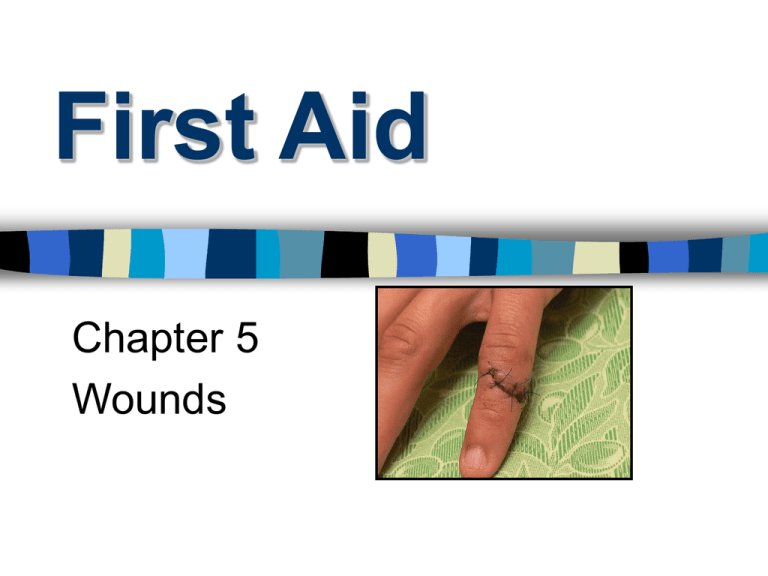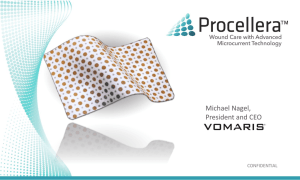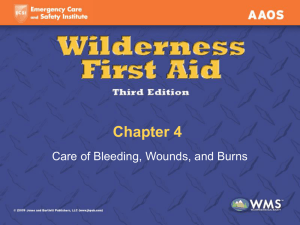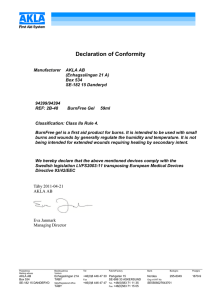First Aid
advertisement

First Aid Chapter 5 Wounds Open Wounds Break in skin surface with external bleeding Open Wounds At risk for blood loss and infection Open Wounds Abrasion Several types of open wounds Laceration Incision Contusion Hematoma Puncture Avulsion Amputation Open Wounds Abrasion Top layer of skin is removed. Little or no blood loss Painful because nerve ending are also abraded Open Wounds Abrasion Ground in debris may be present “Scrape” “Road rash” “Rug burn” abrasion abrasion abrasion Open Wounds Laceration Cut skin with jagged edges. Caused by forceful tearing away of tissue. laceration laceration laceration Open Wounds Incision Smooth edges Resemble surgical cut or paper cut Amount of bleeding depends on depth, location, size incision incision incision incision Open Wounds Puncture Usually deep, narrow wounds in skin and underlying organs. Open Wounds Puncture Entrance is usually small High risk of infection Object may still be present puncture puncture Open Wounds Avulsion Flap of skin is torn loose and hanging. Can bleed heavily Most often involve ears, fingers and hands Open Wounds Avulsion If possible, lay flap flat and realign in normal position Open Wounds Amputation Cutting of tearing off of a body part Fingers, hand, toes, foot, arm leg amputation Open Wounds: What to Do Wear gloves Expose wound Control bleeding with direct pressure Open Wounds: What to Do Cleaning the wound: Helps prevent infection May restart bleeding Open Wounds: What to Do Cleaning the wound: Shallow: Wash with soap and water Irrigate with water SMA as needed Animal bites, puncture wounds, serious wounds: always SMA Open Wounds: What to Do Cleaning the wound: Cover wound with sterile dressing Keep clean and dry Change dressing as needed Open Wounds: What to Do DO NOT Clean large or lifethreatening wounds Scrub a wound Open Wounds: What to Do DO NOT Irrigate with full strength alcohol or Betadine Use hydrogen peroxide Hydrogen peroxide can effect blood flow and wound healing Open Wounds: What to Do DO NOT Soak the wound Close the wound with tape Blow on the wound Infection more likely when bacteria is trapped in wound Open Wounds: What to Do Covering the wound Small does not require sutures: Apply antibiotic ointment Cover with sterile dressing Open Wounds: What to Do Infection Swelling Redness Throbbing pain Drainage Fever Red streaks Chills Serious sign of infection. SMA Open Wounds: What to Do Tetnus Enters a wound with little oxygen, (puncture wound) releases toxins Toxin travels to nervous system, brain and spinal cord Open Wounds: What to Do Tetnus Muscle contractions and paralysis Starts with jaw - “Lock Jaw” No know antidote. Vaccination to prevent Open Wounds: What to Do Amputation Control bleeding Treat for shock Recover amputated part Open Wounds: What to Do Amputation Rinse to remove debris. Do not scrub Wrap in clean dry dressing Open Wounds: What to Do Amputation Place in plastic bag Place in another plastic bag with ice SMA Open Wounds: What to Do Amputation DO NOT: Wrap in wet cloth Place directly on ice Use dry ice Cut off partially attached body part Open Wounds: What to Do Impaled Object DO NOT remove Control bleeding with direct pressure on skin around object Stabilize object Shorten only if necessary Closed Wounds Happens when a blunt object strikes the body Skin is not broken Tissue and blood vessels beneath skin is crushed Closed Wounds Contusion Another name for a bruise. Caused when blood vessels are damaged or broken from a blow to the skin contusion Closed Wounds Hematoma is a collection of blood outside the blood vessels, Caused by internal bleeding hematoma hematoma Closed Wounds What to do: Control bleeding with an ice pack Elastic bandage as needed Check for fracture Elevate to decrease pain, swelling Wounds that Require Attention Arterial bleeding Uncontrolled bleeding Deep or large wound Embedded objects Animal bites Internal bleeding Use Common Sense Sutures “Stitches” Should be done within 6-8 hours of injury Learning Activities 5 Wound Care 1. Wash shallow wounds with soap and water. Yes Learning Activities 5 Wound Care 2. Irrigating a wound with water needs pressure. Yes Learning Activities 5 Wounds 3. Wounds with a high risk for infection require medical attention . Yes Learning Activities 5 Wounds 4. Antibiotic ointment can be applied to any wound. No Learning Activities 5 Wounds 5. Hydrogen Peroxide works well on wounds. No Learning Activities 5 Scenerio: 23 y/o. Knife wound on hand. shallow What to do Apply pressure Clean wound Keep clean and dry Apply dresing Learning Activities 5 Amputation 1. Recover amputated part, take with victim to hospital. Yes Learning Activities 5 Amputation 2. Cut off partially attached part. no Learning Activities 5 Amputation 3. Wrap amputated part in dry, clean cloth. Place in plastic bag. Keep cool. Yes Learning Activities 5 Amputation 4. Keep amputated part buried in ice. No Learning Activities 5 Amputation 5. DO NOT let amputated part become water logged. Yes Learning Activities 5 Scenario: Fingers stuck in mower blade. Two fingers cut off. What to do? Stop bleeding Retreive part – place in bag (ice) Tx for shock Learning Activities 5 Impaled Object 1. Removing an Impaled Object could cause more bleeding Yes Learning Activities 5 Impaled Object 2. Prevent an Impaled Object from moving by placing bulky padding around object Yes Learning Activities 5 Scenario: Construction worker drove large nail through hand. What to do? Don’t remove object Control bleeding SMA First Aid Kits Item Plastic baggie Quantity 1









